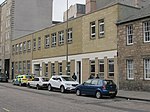Edinburgh School of Medicine for Women

The Edinburgh School of Medicine for Women was founded by Sophia Jex-Blake in Edinburgh, Scotland, in October of 1886, with support from the National Association for Promoting the Medical Education of Women. Sophia Jex-Blake was appointed as both the Director and the Dean of the School. The first class of women to study at the Edinburgh School of Medicine for Women consisted of eight students, the youngest of whom was nineteen years of age. Throughout its twelve years in operation, the school struggled to find financial funding to remain open. A rival institution, the Edinburgh College of Medicine for Women, set up by Elsie Inglis with the help of her father John Inglis, attracted several students of Jex-Blake, including Martha Cadell and Grace Cadell. St Mungo's College and Queen Margaret College in Glasgow also accepted women medical students and when the Scottish universities began to do so the Edinburgh School of Medicine could no longer compete. The school closed in 1898. Over the twelve years of its operation, the Edinburgh School of Medicine provided education to approximately eighty female students. Of those eighty students, thirty-three completed the full course of medical training at the Edinburgh School while many others chose to finish their education at outside institutions.
Excerpt from the Wikipedia article Edinburgh School of Medicine for Women (License: CC BY-SA 3.0, Authors, Images).Edinburgh School of Medicine for Women
Roxburgh Place, City of Edinburgh Southside
Geographical coordinates (GPS) Address Nearby Places Show on map
Geographical coordinates (GPS)
| Latitude | Longitude |
|---|---|
| N 55.947 ° | E -3.184 ° |
Address
Lister Learning and Teaching Centre
Roxburgh Place
EH8 9SU City of Edinburgh, Southside
Scotland, United Kingdom
Open on Google Maps









